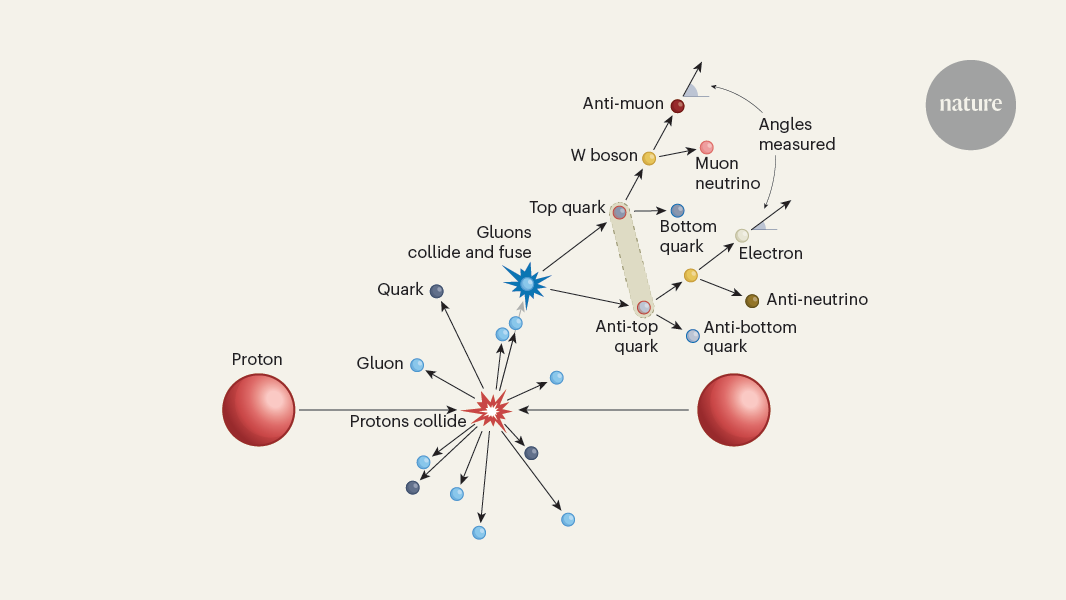Observation of Quantum Entanglement Between Top Quark and Anti-Top Quark at High Energies
Konsep Inti
Quantum entanglement, a key phenomenon in quantum mechanics, has been observed between a top quark and its antiparticle, the anti-top quark, at high energies in particle collisions.
Abstrak
The content describes the observation of quantum entanglement between a top quark and its antiparticle, the anti-top quark, by the ATLAS Collaboration at the CERN particle physics laboratory. Quantum entanglement is a fundamental concept in quantum mechanics where the quantum state of one particle cannot be described independently of the other, even when the particles are separated.
The observation of entanglement between these high-energy particles is significant because it demonstrates that quantum entanglement persists even at the high energies involved in particle collisions. This is an important finding for the development of quantum computing and quantum cryptography, which rely on the principles of quantum entanglement. The author notes that this observation is not unexpected, as it would have been surprising if the quark-antiquark pair was not entangled. However, the ability to detect entanglement at such high energies is an impressive technical achievement.
Terjemahkan Sumber
Ke Bahasa Lain
Buat Peta Pikiran
dari konten sumber
Kunjungi Sumber
www.nature.com
Quarks show that quantum entanglement holds at high energies
Statistik
The ATLAS Collaboration at CERN observed the quantum entanglement between a top quark and an anti-top quark in particle collisions.
Kutipan
"If two particles are entangled, the quantum mechanical state of each particle cannot be described independently of that of the other."
"To observe entanglement at such high energies is an astonishing feat — all the more so because it was detected in a pair of quarks, the fundamental particles making up all atomic nuclei."
Pertanyaan yang Lebih Dalam
How can the observation of quantum entanglement at high energies be leveraged to advance the development of quantum computing and quantum cryptography?
The observation of quantum entanglement between a top quark and its antiparticle at high energies presents significant implications for the fields of quantum computing and quantum cryptography. Quantum entanglement is a fundamental resource for quantum information technologies, as it enables the creation of qubits that can exist in superpositions of states, allowing for parallel processing capabilities that classical bits cannot achieve.
In quantum computing, the ability to manipulate entangled quarks could lead to the development of more robust quantum algorithms and error correction methods. High-energy entangled states may provide insights into creating qubits that are less susceptible to decoherence, a major challenge in maintaining quantum states over time. Furthermore, the principles observed in high-energy particle collisions could inspire new architectures for quantum processors that utilize entangled states more effectively.
In the realm of quantum cryptography, the detection of entanglement at high energies reinforces the security protocols based on quantum key distribution (QKD). The entangled states can be used to generate secure keys that are theoretically immune to eavesdropping, as any attempt to measure the entangled particles would disturb their state, alerting the communicating parties to potential security breaches. Thus, advancements in understanding high-energy entanglement can lead to more secure communication systems and enhance the overall reliability of quantum cryptographic methods.
What are the potential limitations or challenges in detecting quantum entanglement in high-energy particle collisions, and how might these be addressed?
Detecting quantum entanglement in high-energy particle collisions presents several challenges. One significant limitation is the complexity of the interactions involved. High-energy collisions produce a vast number of particles, making it difficult to isolate and identify the specific entangled pairs. The background noise from other particles can obscure the signals of entanglement, leading to potential false positives or missed detections.
Another challenge is the requirement for precise measurements of the quantum states of the particles involved. High-energy environments can lead to rapid decoherence, where the entangled state is lost due to interactions with the surrounding environment. This necessitates advanced detection techniques that can operate at extremely high speeds and with high precision.
To address these challenges, researchers can employ sophisticated data analysis techniques, such as machine learning algorithms, to sift through the large datasets generated by particle collisions and identify patterns indicative of entanglement. Additionally, advancements in detector technology, such as improved sensors and faster readout systems, can enhance the ability to capture and analyze the quantum states of particles in real-time, thereby increasing the likelihood of successfully detecting entangled states in high-energy environments.
Given the fundamental nature of quarks, what insights might the observation of their entanglement provide into the underlying principles of quantum mechanics and the nature of reality?
The observation of entanglement between quarks, particularly at high energies, offers profound insights into the foundational principles of quantum mechanics and the nature of reality. Quarks are fundamental constituents of matter, and their entanglement challenges classical intuitions about separability and locality. This phenomenon exemplifies the non-local nature of quantum mechanics, where the state of one particle is intrinsically linked to the state of another, regardless of the distance separating them.
Such observations reinforce the concept of quantum superposition and the idea that particles do not possess definite states until measured. This has implications for our understanding of reality, suggesting that the universe at a fundamental level is interconnected in ways that defy classical explanations. The entanglement of quarks may also provide insights into the behavior of matter under extreme conditions, such as those found in the early universe or in black holes, potentially leading to new theories that bridge quantum mechanics and general relativity.
Furthermore, studying quark entanglement can enhance our understanding of quantum field theory and the Standard Model of particle physics, as it may reveal new interactions or symmetries that have yet to be discovered. Overall, the entanglement of quarks not only deepens our comprehension of quantum mechanics but also invites philosophical inquiries into the nature of reality itself, challenging our perceptions of independence and connection in the universe.

